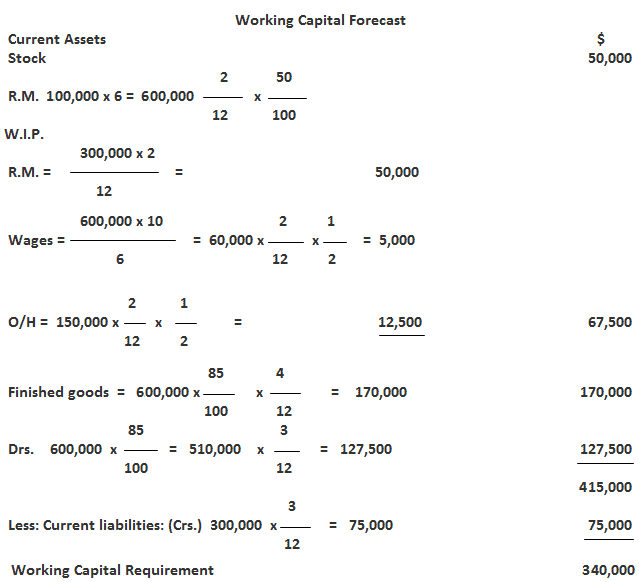X Ltd Co. wants to estimate its working capital using the operating cycle method when: Customers are given 60 days of credit and 50 of days credit from suppliers. The 40-day supply of raw materials and a 15-day supply of finished goods are kept in store. The production cycle lasts 20 days. All materials are issued at the start of each production cycle. One-third of the average working capital is kept as a cash balance for contingencies. (c) No. of operating cycles in the year = 365 / 85 = 4.3 (d) Working capital = 87,500 / 4.3 = $20,349 Add: Reserve for contingencies 1 / 3 = 6,789 / $27,132 Contingencies allowances = 15% Required: Calculate the amount of working capital. Account Receivables (Drs) Local sales = (1,56,000 x 2) / 52 = $6,000 Outside sales = (6 x 6,24,000) / 52 = $72,000 Less: Current Liabilities Accounts Payables (Crs.) = (1,92,000 x 4) / 52 = $14,770 O/S Wages = (5,20,000 x 2) / 52 = $20,000 Add: 15% for contingencies = 10,385 Total working capital required = $79,615 John Trading Co. has asked you to prepare a working capital forecast using the following information: Raw materials remain in stores for 2 months, finished goods remain in stores for 4 months, the credit allowed by crs. is 3 months from the date of delivery of goods (Rm), and the credit given to Drs. is 3 months from the date of dispatch. The production cycle is 2 months. Additionally, the sale price per unit is $6, and production and sales are uniform throughout the year. Libro Ltd. has $350,000 share capital, $70,000 G.R., $300,000 fixed assets, $30,000 stock, $97,500 Drs., and $15,000 Crs. The company proposes increasing the business stock level by 50% at the end of the year. Credits are doubled and it is proposed that machinery worth $15,000 should be purchased. Estimated profit during the year is $52,500 after changing $30,000 depreciation and 50% of profit for taxation. Advance income tax is estimated at $45,000. Credits are likely to be doubled, 5% dividends will be paid, and 10% dividends are to be proposed for the next year. Drs. are estimated to be outstanding for 3 months. The sales budget shows $750,000 as sales for the year to make a working capital forecast by the projected balance sheet method.1. Estimating Working Capital Requirement Using Operating Cycle Method
Problem
Solution
Total Op. Exp. For the Year
$
R.M. 20,000 x 250
50,000
Labor 20,000 x 1
20,000
Overheads
17,500
87,500
Period of Production cycle
Days
Material storage days (pds.)
40
Finished goods storage (pds.)
15
Production cycle storage (pds.)
20
Av. collection (pds.)
60
135
Less: average payment (crs.)
50
85
2. Using Working Capital Method
Problem
$
Raw materials (needed)
10,000
Store value
16,000
Average credit givers:
Local sales 2 weeks credit
1,56,000
Outside sales 6 weeks credit
6,24,000
Time lag payment:
For purchase (4 weeks)
1,92,000
For wages (2 weeks)
5,20,000
Solution
Inventories: R.M.
$10,000
Stock of Store
$16,000
$26,000
3. Using Cash Forecasting Method
Problem
Solution

4. Using Projected Balance Sheet Method
Problem
Solution
(i) Sh. cap.
Fixed assets
300,000
Cap. (Given)
350,000
350,000
M. proposed purchase
15,000
Res. and surplus
70,000
Less dep.
315,000
17,500
30,000
Less dividend 10%
52,500
285,000
52,500
C.A.
+ Profit after tax
105,000
70,000
Stock 30,000 + 50% add. drs. 15,000
45,000
Less proposed div. 10%
35,000
Adv. tax 45,000
187,500
Current liabilities
277,500
Crs. 15,000
+ (k) 15,000
30,000
Tax provision
52,000
Proposed div.
35,000
O/D (balance figure)
25,000
170,500
562,500
562,000
Estimating Working Capital Requirements FAQs
Working Capital is the difference between current assets and current liabilities. It represents the amount of money which a company has in hand to run day to day business.
To solve Working Capital requirement problems, you must first understand what they are asking for. Then determine how much of each current asset and current liability the company needs to have on hand so it can meet its short term obligations. Once you have determined these amounts add them all up to get the total Working Capital.
Working Capital = current assets – current liabilities. The number will always be a positive amount because it represents how much money the company has in hand to meet its short term financial obligations. If current assets are greater than current liabilities, you have a positive Working Capital position or what is called a funding surplus. If current liabilities are greater than current assets you have a negative Working Capital position or what is called a shortfall.
No, it is not. Working Capital represents the difference between current assets and current liabilities at a given point in time whereas net worth represents all of the assets and liabilities of a company at a given point in time. Net worth is equal to total assets less total liabilities and shareholders' equity which includes the capital stock, Retained Earnings and other forms of equity.
Net worth = total assets – total liabilities. The number will always be a positive or negative amount. If total assets are greater than total liabilities, you have a positive net worth position and if liabilities are greater than assets you have a negative net worth position.
True Tamplin is a published author, public speaker, CEO of UpDigital, and founder of Finance Strategists.
True is a Certified Educator in Personal Finance (CEPF®), author of The Handy Financial Ratios Guide, a member of the Society for Advancing Business Editing and Writing, contributes to his financial education site, Finance Strategists, and has spoken to various financial communities such as the CFA Institute, as well as university students like his Alma mater, Biola University, where he received a bachelor of science in business and data analytics.
To learn more about True, visit his personal website or view his author profiles on Amazon, Nasdaq and Forbes.











